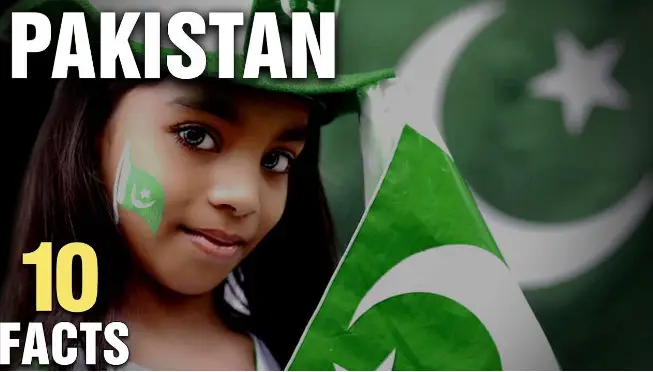
10. Incredible geographic location
Pakistan is a Muslim country located in South Asia, which shares its borders with China, India, Afghanistan, Iran, and the Arabian Sea. Its significant geographic location is a great attraction for developed economies to invest for lucrative profits. Pakistan extends from 24 ° to 37 ° N latitude and from 61 ° to 75 ° E longitude. It is a very important country due to its geographical location. Pakistan is a union of South Asia, West Asia, and Central Asia. Pakistan has a large number of plains and plateaus including coastal areas, Upper and Lower Indus Plains, the Balochistan Plateau, the Salt Mountain Range, and the Potwar Plateau.
Countries like Tajikistan, Turkmenistan, Kazakhstan, Uzbekistan, and Kyrgyzstan lie north of Pakistan and are completely surrounded by drought, but are rich in natural resources. Pakistan has developed religious, cultural and commercial relations with these Islamic states. Pakistan offers the shortest sea route to Central Asian countries.
Thanks to its geographical location, the people of Pakistan enjoy the climate of all four in a year. It has all kinds of landscapes such as deserts, forests, mountains and beaches. If the government takes action and makes these places easily accessible, Pakistan may be the next Switzerland. Northern areas like Naran, Kaghan, Swat Valley and thousands of more glorious places make Pakistan one of the most beautiful countries in the world.
There is much more to the geographical location of Pakistan, but it cannot all be mentioned in one small paragraph. Let’s move on to the next point!
9. The only nuclear state of the Islamic State
Pakistan is the only Islamic state that has nuclear power to date. Pakistan is a nuclear-armed Islamic state thanks to Abdul Qadeer Khan. He is a Pakistani nuclear physicist who made Pakistan the first Islamic state equipped with nuclear weapons. He is known as the “father of Pakistan’s nuclear bomb”. He is known for Pakistan’s nuclear weapons program, gaseous diffusion, martensite morphology, and graphene.
Pakistan had to improve its defense capabilities due to aggressive neighbors such as India and had to create a “balance of power in the region” or come under continuous threat of violence.
8. Story full of heroes and fights
Pakistan has a great history full of heroes and their struggles. From Muhammad Bin Qasim to Quaid-e-Azam, it can be seen. The Mughals, the Afghans, the Khalji dynasty and present-day Pakistan are the result of the heroic deeds of Muslim heroes. One of the great recent heroes in Pakistani history is Quaid-e-Azam, whose real name was Muhammad Ali Jinnah. He is also known as “The Father of the Nation”. He was the person who fought with the British and the Hindus. And he founded a country, known as the Islamic Republic of Pakistan. And he is not the only one who fought for this state, but there are thousands more. For example, Allama Iqbal, Fatima Jinnah, Liaquat Ali Khan, Sir Syed Ahmad Khan, Chaudhary Rehmat Ali, Sir Aga Khan, etc.
We cannot forget at all the efforts and sacrifices of the Muslims who lived in the subcontinent at that time. There are thousands of heroes who are not even known from history. May God bless you all (Ameen). After the end of the Mughal Empire, the British took over the subcontinent. In 1857, Muslims and Hindus joined forces to fight them. They started a war against them and called it “The War of Independence.” But sadly, fate was not in favor. The British won the war with their armed force and the dark age of the Muslims began. The Hindus got the British to think that Muslims had a greater stake in the war of independence.
As a result, the Hindus grew closer to the British and the Muslims were oppressed. Muslims were a minority on the subcontinent. The Muslims were still in fantastic pride thinking about their rule and the Mughal Empire. They thought that Muslims were still powerful, they were not prepared to face the truth.
As a result of this pride, the British oppressed the Muslims and took over a Hindu-British government. This pride of Muslims also prevented them from studying the modern language. Atlast, some heroes took action and started to make the Muslims realize what a big mistake they had made. They were 50 years behind in their studies than the Hindus. Some movements such as the Aligarh and Caliphate Movement (Khilafat) also began. Much time, blood, effort and hard work that every sincere Muslim spent, it was not in vain and an Islamic state called Pakistan was born.
7. Place of settlement of the Indus Valley civilization
Pakistan has a larger part of the place where one of the world’s first civilizations settled. They began to live on the banks of the Indus River. Its ruins have been found at Mohenjo-Daro, Harappa, and Taxila. The meaning of Mohenjo-Daro is “City of the Dead”. It was given this name because when the ruins were found, there was a house-like structure with hundreds of human skeletons and skulls in it. Nobody knows why and how this happened. Rumor has it that this was the work of the Aryans. Historians confirm several Aryan attacks on the Indus Valley civilization.
The religion of the Indus Valley civilization has not been confirmed to this day. But when the Aryans invaded them, they found temples with idols in them. They also found some books with some things written on them. They began to follow the book and then broke up into groups, which is now known as the strict cast system of Hinduism. The Aryans made a religion, called Hinduism. People to this day go to visit the ruins of the Indus Valley civilization. But it is still a mystery to be solved; How did they end? Did the Aryans kill them? Did they start living with another civilization? Was there a natural disaster? No one knows for sure.
Pakistan is full of historical structures and ruins. The most famous of them is the Mohenjo-Daro.
6. Land of cultural diversity and traditions
Pakistan is a country with great culture and traditions. The culture of Sindh, Punjab and Khyber Pakhtunkhwa fascinate tourists very much. Sindh culture is the most unique in my opinion. Their dresses, hats (ajraks) and other traditional things are very interesting. The people of Sindh speak Sindhi as a local language and Urdu as a national language. They are very hospitable and friendly.
Punjab culture and traditions are also well known. The people of Punjab are considered to be the most hospitable people in the world. They pride themselves on treating tourists and even locals as friends and family. Her main dress is Shalwar kameez. Punjab is a land of burning deserts, great forests, plains, snow-capped mountains, and five great rivers. The word Punjab means “The land of the five rivers”.
Then comes the culture and heritage of Khyber Pakhtunkhwa (KPK). It should be noted that the culture of Gilgit Baltistan is very similar to KPK. In fact, KPK and Gilgit Baltistan were the same province at the same time, but later they split. KPK is the land of Pathans. Pathans are very religious people. They are strong, patriotic, educated, hospitable, and compassionate to everyone.
The culture and heritage of each province of Pakistan is unique with some similarities.
5. The highest paved highway in the world (Karakoram Highway)
Pakistan has the highest paved highway in the world, called the Karakoram Highway. It has been given this name because it passes through the Karakoram Range (this range is home to the second highest peak in the world, K2. Also known as Karakorum 2). The maximum height of this road is 4,714 m (15,466 ft) near the Khunjerab pass. Due to its high elevation and the difficult conditions in which it was built, it is often referred to as “The Eighth Wonder of the World.”
The Highway is also known as the “China-Pakistan Friendship Highway” because it connects Pakistan with China. The highway connects Punjab and Khyber Pakhtunkhaw (two provinces of Pakistan) and Gilgit Baltistan (province of Pakistan) with the Xinjiang Uyghur Autonomous Region of China. The highway is 1,300 km (810 miles) long. It starts from Hasan Abdal (city located in Pakistan) to Khunjerab, Gilgit Baltistan (province of Pakistan). Here it enters China.
The main towns and cities that this highway connects are: Islamabad (Pakistan), Rawalpindi (Pakistan), Abbottabad (Pakistan), Kohistan (Pakistan), Gilgit (Pakistan), Upal (China), Tashkurgan (China), Kashgar (China) . and many others. Karakoram Highway in Akto Country, Xinjiang (China) Karakoram Highway in front of Juglot, Gilgit (Pakistan).
There are many more facts and information about the Karakoram Highway, but they cannot all be mentioned here.
4. Second most beautiful capital in the world (Islamabad)
With a population of 1,129,000, Islamabad ranks second on the list of the 10 most beautiful capitals in the world. Islamabad is located on the Potohar Plateau. It was also the plateau where the Indus Valley civilization lived. The name of the city “Islamabad” means “The city of Islam”. Its foundation was established in 1960 and it was announced as the new capital of Pakistan on August 14, 1967. It is the second capital of the country (the first capital was Karachi but it was changed because it was always at high risk of attacks and natural disasters such tsunamis). Before it became the capital, it was called “Potohar region”.
The city’s climate is humid subtropical and, like most of Pakistan, this city also enjoys all four types of climate. The natural beauty found in its natural setting is incomparable. It bewitches everyone who visits it. In addition, it is not only surrounded by high and lush mountains, but there are also waterfalls that make it more attractive. In addition, it has a mountainous region called “Margalla Hills”.
The places that people recommend to tourists are Lok Virsa Museum, Rawal Lake, Faisal Mosque, Pir Sohawa, Islamabad Zoo, Pakistan National History Museum, Centaurus Mall, etc. It has a twin city called Rawalpindi. Along with him, its population is almost 4.5 million.
Islamabad is a great attraction for tourists visiting Pakistan. It is one of the most important tourist destinations in Pakistan.
3. Homeland of the Great Humanitarian, Abdul Sattar Edhi
The great Pakistani humanitarian Abdul Sattar Edhi was born on February 28, 1928 in Bantva, India. He was a kind, polite and helpful person. The Edhi Welfare Organization or Edhi Foundation is a non-profit organization, founded by Abdul Sattar Edhi in 1951. He served this organization as director until his death. This organization manages the largest network of voluntary ambulances in the world. This organization has also developed homeless shelters, animal shelters, rehabilitation centers, and orphanages throughout Pakistan in various locations. The organization has been serving humanity day and night since its founding.
Abdul Sattar Edhi belonged to a poor background. He lived like a poor man in a small house with his wife, two sons and two daughters. The cause of his death was kidney failure. He was hospitalized on June 25, 2013 and would be on dialysis for the rest of his life unless he found a kidney donor. On July 8, 2016, he passed away from complete kidney failure at the age of 88. When he passed away, he was registered as the guardian or parent of 20,000 children. He is known as “The Angel of Mercy”. Edhi is also known as “The Most Tolerant”, which stems from his unwavering ability to accept people as they are. After his death, his son Faisal Edhi took the place of his father.
2. The youngest Microsoft expert in the world (4 years)
Arish Fatima, a four-year-old from Karachi, earned the status of “Youngest Microsoft Certified Professional (MCP)”. She took the MCP exam and scored 831 points. The minimum scores to pass the MCP exam are 700, while she surprisingly scored 831. The government of Pakistan announced this on a Friday via Twitter and Geo News also reported it. Arish’s father Osama is also an IT expert and is proud to see her daughter doing wonders in this field.
1. World’s deepest sea port (Gwadar port)
The port of Gwadar is known as the deepest sea port in the world. It is located in the Balochistan province in Pakistan. What is the benefit of a deep sea port? The depth of the water helps them access deep water ports. The regular ports are generally recreational type where the water is no more than 20 feet deep, while the deep water port is compatible with large heavy cargo ships that may require the water to be 30 feet deep or even more. Gwadar port is the best option for ships like that as it is the deepest sea port. This port is very important to transport trade by sea from South Asia and the world.
Pakistan is the land of unique peoples, traditions, heritage and culture. Here, you only read about one drop. A small list like this cannot describe the beauty that Pakistan possesses.





